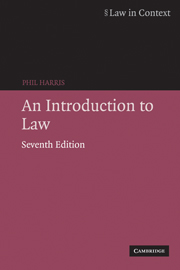Book contents
- Frontmatter
- Contents
- Preface
- Table of statutes
- Table of cases
- 1 Law and society
- 2 Law and morality
- 3 Law and the regulation of economic activity
- 4 Some important legal concepts
- 5 Law and property
- 6 Law and the settlement of disputes
- 7 The making of legal rules
- 8 The European dimension of English law
- 9 Liability in English law: the law of tort
- 10 Liability in English law: crime and the criminal justice system
- 11 The development and the role of the contract
- 12 Law and government
- 13 The legal profession
- 14 The judges
- Index
11 - The development and the role of the contract
- Frontmatter
- Contents
- Preface
- Table of statutes
- Table of cases
- 1 Law and society
- 2 Law and morality
- 3 Law and the regulation of economic activity
- 4 Some important legal concepts
- 5 Law and property
- 6 Law and the settlement of disputes
- 7 The making of legal rules
- 8 The European dimension of English law
- 9 Liability in English law: the law of tort
- 10 Liability in English law: crime and the criminal justice system
- 11 The development and the role of the contract
- 12 Law and government
- 13 The legal profession
- 14 The judges
- Index
Summary
The contract is the legal cornerstone of all transactions in business and consumer life. It is the legal device which facilitates exchange of goods or services between individuals and groups (such as businesses) in our society, and may be defined as a legally binding agreement between two parties whereby each party undertakes specific obligations or enjoys specific rights, conferred by virtue of that agreement. The expression ‘breach of contract’ refers to the fact that the agreement is legally binding: if one party fails to honour his or her part of the bargain, then the other can sue, and obtain a remedy through the courts for that breach.
Of course, not every agreement is a legally binding contract. Purely social or domestic agreements, mere requests by one party for information, a series of negotiations between two parties and collective agreements between trade unions and employers have been held by the judges not to constitute contracts, and the judges have also refused to regard lotteries or football pools transactions as legally enforceable contractual relationships. Regarding social and domestic arrangements, the courts have asserted that the parties to the agreements did not intend to enter into a legal relationship, and this ‘intention to create legal relations’ is often said to be one of the legal conditions for the formation of a contract.
- Type
- Chapter
- Information
- An Introduction to Law , pp. 349 - 385Publisher: Cambridge University PressPrint publication year: 2006



